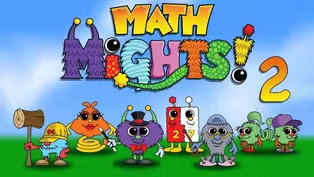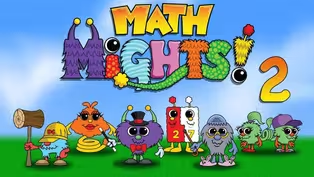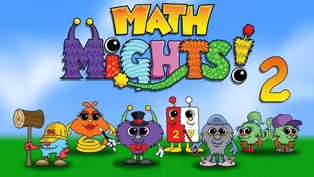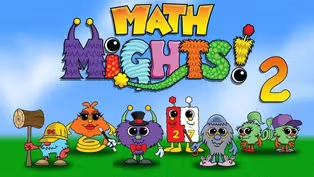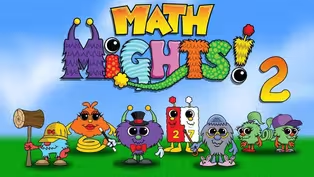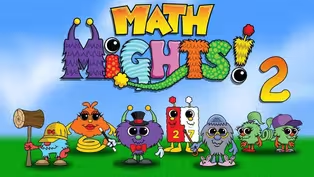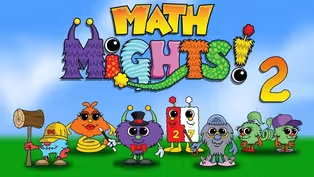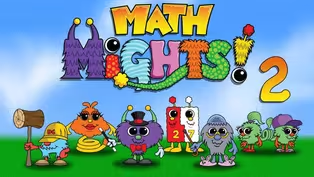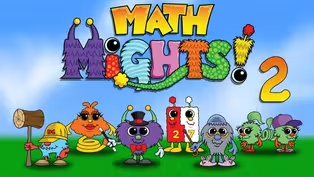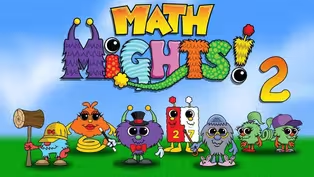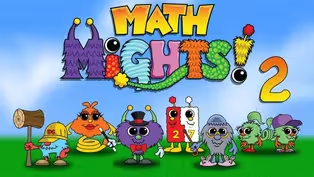Math Mights
Compose 3-Digit Numbers
Season 2 Episode 218 | 16mVideo has Closed Captions
Join Mrs, McCartney for a Number Talk with her friend Springling!
Join Mrs, McCartney for a Number Talk with her friend Springling! Be ready to build 3-digit numbers in different ways with base ten blocks and place value discs.
Problems playing video? | Closed Captioning Feedback
Problems playing video? | Closed Captioning Feedback
Math Mights is a local public television program presented by Detroit PBS
Math Mights
Compose 3-Digit Numbers
Season 2 Episode 218 | 16mVideo has Closed Captions
Join Mrs, McCartney for a Number Talk with her friend Springling! Be ready to build 3-digit numbers in different ways with base ten blocks and place value discs.
Problems playing video? | Closed Captioning Feedback
How to Watch Math Mights
Math Mights is available to stream on pbs.org and the free PBS App, available on iPhone, Apple TV, Android TV, Android smartphones, Amazon Fire TV, Amazon Fire Tablet, Roku, Samsung Smart TV, and Vizio.
Providing Support for PBS.org
Learn Moreabout PBS online sponsorshipMore from This Collection
"Math Mights" lessons for 2nd Grade students.
Video has Closed Captions
Join Mrs. McCartney for some fun with Professor Barble. (15m 59s)
Video has Closed Captions
Join Mrs. McCartney for some fun with Professor Barble. (15m 59s)
Video has Closed Captions
Join Mrs. McCartney for some fun with Professor Barble doing a tricky comparison. (15m 59s)
Video has Closed Captions
Join Mrs. McCartney for a word problem with Professor Barble that will make more sense. (15m 58s)
Video has Closed Captions
Join Mrs. McCartney for a comparison word problem with her friend Professor Barble. (15m 59s)
Compare 3-Digit Numbers Part 2
Video has Closed Captions
Join Mrs. McCartney to learn how to do a comparison word problem with Professor Barble! (15m 59s)
Comparing Numbers on a Number line
Video has Closed Captions
Join Mrs McCartney for a word problem with Professor Barble using Visula Models! (15m 59s)
Compare 3-Digit Numbers Part 1
Video has Closed Captions
Join Mrs. McCartney to see if we can figure out Professor Barble's comparison. (15m 59s)
Numbers represented in different ways
Video has Closed Captions
Representing numbers in different ways to show off your learning with place value. (15m 59s)
Video has Closed Captions
Put numbers together and taking them apart with expanded form. (15m 59s)
Video has Closed Captions
Join Mrs, McCartney for a Number Talk with her friend Springling! (15m 59s)
Subtraction with 2-Digit Numbers Part 2
Video has Closed Captions
Join Mrs. McCartney for an addition number talk with D.C.! (16m)
Providing Support for PBS.org
Learn Moreabout PBS online sponsorship(dramatic orchestral music) (magic chimes) (Springling boinging) (dramatic orchestral music) (Dotsan screeching) - [All] Math Mights.
- Welcome second grade Math Mights.
Are you ready to have some fun in math?
My name is Mrs. McCartney.
I'm so excited that you've joined us today.
Let's check out our plan for today.
We're gonna start off first with a number talk with my friend Sprinkling using the open number line.
Then we're gonna move more into place value composing three-digit numbers.
Let's start off first with our number talk to help warm up our math brain.
You might be asking, what is a number talk?
How do I do this?
Well, it's three easy steps.
We're gonna pose a question with a problem that you're already familiar with.
So you're gonna know the operation and it's about really applying it in a mental way so that step two is really trying to solve that problem mentally without pencil and paper.
And then we're gonna share out how you solved it, and maybe even you could compare it with how somebody else solved it.
You may agree or disagree with the way someone solves it.
And that's okay, because we're all learning different ways to solve problems.
I wonder which Math Might is going to help us with our number talk today.
(Springling boinging) You guessed it, it's Springling.
Springling loves to hop on the open number line.
She loves to look at the distance between two numbers.
She was born with a coily tail, fancy eyelashes, and she's really fluffy because she loves to hop far on the number line.
I want you to be thinking of Springling as you're thinking of this number talk today.
Let's see what the problem is that she has for us today.
The problem today is 56 minus 28.
Think of the open number line.
Are you gonna count up or are you gonna count back?
Do you know of some friendly numbers that we might see along the way?
Let's check out to see how my friend Fatima solved this problem.
She used Sprinkling while solving this.
She started at 28 and counted up to a friendly decade number, 30.
Let's take a closer look to see how she solved this.
Fatima started at the number 28 and then she hopped to that next friendly decade.
If you're at 28, what is the next friendly decade number?
Of course, it's 30.
We're gonna go ahead and put our 30 on here and tell Springling to get ready that she's gonna hop.
Springling hop.
We know that she went two.
Now, when Fatima did this, she did this next step by kind of doing two decade numbers.
She skipped the 40 and went all the way to 50.
It's okay on your number line if you need to hop to the 40 and then stop, and then go to 50, but we can have further and Springling just loves it when you do this because it makes her fur super fluffy.
Are you ready?
Hop Springling!
Hop!
From 30 to 50, we know that she went 20.
Now, from 50 to 56 seems kind of easy.
So when we have here, we're gonna put that total there in the center, which is six.
She loves to keep track of her hops.
So we're going to add these together, 20 plus six plus two gives us the answer that Fatima came up with, which was 28.
Great thinking Fatima.
I wonder what our friend Kaisa thinks about Fatima's thinking with her number talk.
She said, "I agree with the way Fatina solved the problem.
I used the same strategy, so she must have used Springling, but she did it in a different way."
Let's check out to see how Kaisa solved it.
She also solved it on that open number line but she did not go from 28 to 30.
She went from 28 all the way to 48.
That's a really far jump.
Let's check that out as we work this problem out together.
The problem is 56 minus 28.
If we look at this on the open number line, we'll start at 28 like we did before, end it at 56.
This is the best thing about the number talk, is seeing kids solve it different ways.
Fatima went to the 30 but Kaisa decided to go all the way up here to 48.
Boys and girls, why do you think she decided to do that?
Well, I think that she was thinking, maybe that she could skip count by tens with any numbers, you could go from 28 to 38 to 48.
And so she wanted sprinkling to do a large hop here because 20 is easy to kind of count up looking at it this way.
Next, she went from 48 to the next friendly number which is 50, not too far away.
A nice easy hop to make that two.
50 to 56 we know is six.
If we add up Springling's hop, we know that we can add our 20 plus our six plus our two to get the 28 that Kaisa thought of.
We saw Springling used in two ways with the same strategy but kind of different ways of going about it.
Did you solve it the way Fatima did or maybe the way that Kaisa did?
I wonder if you solved it with a different strategy?
I bet that you're getting really good at your subtraction.
Let's check out what our I can statement is for today.
Our I can statement today is that I can compose three digit numbers using place value understanding.
You guessed it!
We're gonna do more place value with our place value blocks, and even our place value disks.
And I wonder if a Math Might friend might join us today in our episode.
Let's see first what we're gonna look at.
I have a bucket of base 10 blocks and I wanna see if you can help me sort them.
Here is my bucket.
I can see that I have hundreds in here, I have tens in here, and I even have ones.
I wonder, boys and girls, how could we solve to figure out how many hundreds, how many tens, and how many ones?
Okay, now my bucket is completely empty.
I went ahead to make it easier for us and sorted the hundreds, the tens and the ones.
How many hundreds do we have is quite easy, two.
If I put these in rows of 10, I tried to organize it to make it easier for us to solve.
Let's check it.
One, two, three, four, five, six, seven, eight, nine, 10.
This row is also 10, so that makes 20 tens.
21, 22, 23, 24, 25, 26, 27, 28 tens.
And then if I look over here at my ones, it's nice when you can organize them in sets of 10.
So I have five and five, which makes 10, and then 15.
So, two hundreds, 28 tens and 15 ones.
If we were to fill this in and write it out to show how many tens and ones and hundreds there are, it would look like this: Two hundreds, 28 tens, and then 15 ones.
If we wanted to take this a step further, how could we represent the same amount that we have here but use the fewest number of blocks possible?
Let's see what Fatima and Kaisa think.
Fatima says, "I know we could take 20 tens to make two hundreds."
Hmm, what do you think about that?
Let's take a look at our place value blocks to see if we can act out how Fatina is thinking of this.
She says that we can take these 20 tens and we can trade them out 'cause they equal 100.
Remember, we've talked about before that on here this is 10 tens, and 10 tens equals 100.
So let's go ahead and trade these out for a block of 100.
We'll take these 10 tens and trade them out for another block of 100.
So now I have four hundreds and then I still have my eight tens and then over here I have my 15 ones.
Let's see what Kaisa was telling us.
She said, "We could take 10 ones and make one 10."
Remember, we're trying to get the fewest number of blocks.
So, we could take the 10 ones right here and exchange it for another 10.
We've now reduced down all of the blocks that we were using to the fewest number of base 10 blocks.
When we look at the differences between these, you can kind of see how we sort of renamed the numbers.
We initially started off with two hundreds, 28 tens and then 15 ones, and then we reduced it down to four hundreds, nine tens, and five ones.
Great job thinking of how you can use place value in different ways.
How could we put this into a number?
We had four hundreds, nine tens and five ones.
I think I know who we have to call on.
We have to call on my friend Value Pak for this one.
Have you ever met Value Pak?
(Value Pak popping) Value Pak is a part of a family in Math Flip.
When they click together, they wear their value on their bellies.
We can even use the Value Pak into hundreds and thousands and even decimals.
But when the Value Pak unclicks, they can separate their value.
So let's look at this number 27, that's their value together.
As they separate, they break apart in to 20 and seven.
We can also do this as we look at numbers in the hundreds.
So our number that we have is 495.
Let's first look at it before we draw what that looks like.
So over here I have my four hundreds, I have my nine tens and my five ones.
The Value Pak is going to show their value on their belly which shows that 400.
And then we kind of hide the zeros 'cause everybody has their place when they click together.
Here we have our nine tens which represents the 90, and then our five ones.
So there you go.
You can see 495.
Let's see now if we can do this in a drawing so we could record to show how we know all of this information.
Here we have that number, 495.
We were showing it with all of those base 10 blocks.
But you might be asking yourself, how am I going to record this?
I like to call it, base 10 shorthand.
Sometimes you could say a base 10 drawing.
So let's see, if I first wanted to start off with making my 400, I'm gonna draw squares that represent those kinds of waffle squares that we were looking at.
That would represent my value of 400.
If I wanted to do my 90 or my nine tens, I'm just gonna draw straight lines to be able to show my groupings of my nine tens.
If I wanted to show my ones, I'm just gonna go ahead and use dots for those one, two, three, four, five.
So really great, great quick draw to really represent our four hundreds, nine tens, and five ones, which represents our number, 495.
Do you remember last time we talked about the difference between proportional and non-proportional?
It's a huge second grade concept that I wanna make sure you understand.
Proportional means things that are one and then we can put them together and they're sort of equal to each other, like base 10 blocks or even unifix cubes.
We also can use non-proportional tools in second grade to understand place value even better.
You can use place value disks or other non-proportional things like maybe coins where a dime is worth 10 and it's smaller, but a nickel is a larger and it's worth five.
We have some place value disks here that we want you to take a look at.
Maya has some of those non-proportional manipulatives that I were just talking about on a tray.
If we were to look at that, it looks like a lot to count.
That's why it's really important to help organize it.
How many hundreds do you see, how many tens, and how many ones?
Let's check out her tray of place value disks.
I kind of organize them for us with our hundreds, our tens, and then our ones.
I know that I have one 100, I have seven tens.
and then if I look here, I have 10 and six more which means that I have 16 ones.
If we wanted to record it, it would look like this, one hundred, seven tens, and then 18 ones.
I'm wondering if you can take these and use the fewest number of disks to be able to create this same amount.
Let's see what our friends think.
Our friend Fatima says that we could take 10 ones and make it one 10.
Do you think that would work?
Let's take a look at it here.
We have 10 ones.
We know that those 10 ones is equal to one 10.
So, Fatina is saying that we can clear these 10 ones off and be able to put one more 10.
That was really great thinking.
Kaisa also has an idea.
She says she wonders if we still have the same amount.
Do you think that we have the same amount when we exchanged it?
I wonder.
If we still look back here, we had that 10 that represented the 10 ones.
We didn't actually add or take away any, we simply exchange those 10 ones for 10.
So the amount is the same.
Our new amount here if we were to record it is one hundred, eight tens, and eight ones.
I wonder if we could ask Value Pak to help us show the value of what all of this is worth.
Let's see if we can put that together as we look at it.
We have the number 188.
Let's see if we can build that next to our diagram that we have here.
We have our 100.
Moving down to the tens, we have our eight tens, which equals 80.
And then when we move this down to our ones, we know that we have eight ones.
So we can show that this number is 188.
The reason with Value Paks clicked together, if we separate it, we can see here that same value really is demonstrated in the disks that we have here.
It's so much fun to be able to see the place value disks with the place value strips.
It's now gonna be your turn to try to do something on your own guessing what number we're describing.
It's called, Who Am I?
We had so much fun today, second grade Math Mights.
You're getting so smart with your understanding with place value.
I sure hope that you join me next time.
(upbeat music) (upbeat music continues) - [Narrator] Sis4teachers.org.
(air whooshing) Changing the way you think about math.
- [Narrator] This program is made possible with funding from the Michigan Department of Education: Governor's Education Emergency Funds, the state of Michigan, and by viewers like you.
(upbeat music)


- Home and How To

Hit the road in a classic car for a tour through Great Britain with two antiques experts.












Support for PBS provided by:
Math Mights is a local public television program presented by Detroit PBS
